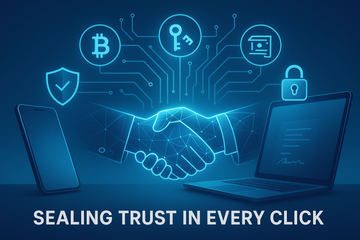Picture this: you're about to send a hefty crypto transaction, maybe a pile of Bitcoin, or perhaps you're just approving a contract on your laptop. Either way, what’s stopping some internet trickster from swooping in and rewriting the message? The answer lies in a marvelously simple but brilliant creation—the digital signature. But what actually is it, and why are folks in crypto, finance, and beyond so obsessed with its power?
You Signed Where? Understanding the Digital Scribble
Let’s keep it real for a second. Most of us know what it feels like to scribble our name at the bottom of a receipt, right? Like a little seal of approval, your physical signature says, 'Yep, that's me.' Now, imagine doing that online. A digital signature is kind of like the high-tech cousin of your handwritten scrawl. It’s an encrypted, electronic imprint that confirms you’re really you—and that whatever you sent hasn’t been messed with.
More technically, we’re talking about math—a bucketload of it, actually. Digital signatures use something called public key infrastructure (or PKI, if you want to sound fancy at parties). Basically, you get a pair of keys: one is private (think of it as your secret password), and the other is public (like your official calling card). You sign with the private key, and others verify with the public one.
But How Does It Work? Let Me Explain
So, here’s the rundown. Say Alice wants to ping Bob a message. She writes her message, and then her computer creates a hash—a mathematical summary of the message. Next, Alice's private key encrypts this hash. That’s her digital signature, right there. Bob, on his end, can use Alice’s public key to decrypt that signature and check: does the hash match the message’s summary? If yes, Bob’s all smiles—the message came from Alice and nobody’s been monkeying around with it.
- Authenticity: The signature shows the message really came from Alice.
- Integrity: If anyone tweaks the message, the signature stops working. Instant red flag.
- Non-repudiation: Alice can’t turn around and claim she never sent it. Her private key signed the darn thing.
Remember, your private key should never leave your device—just like you wouldn’t hand your house keys to a stranger! That’s why hardcore crypto folks use hardware wallets like Trezor or Ledger. These nifty gadgets stash your keys away from snooping eyes, signing transactions right on the device for that extra security hug.
Why All the Fuss? The Hidden Power Beneath the Surface
You might be asking: isn’t an electronic signature enough? Not quite. While any squiggle on a tablet can be 'electronic,' digital signatures actually guarantee both who is signing and what is signed. That’s the magic sauce that makes them acceptable in court, business, and yeah, the wild world of crypto.
Plus, digital signatures are everywhere, almost invisibly. Signed software updates? That’s how your phone knows you’re not downloading a virus disguised as a weather app. Secure emails in corporate settings? Again, digital signatures strutting their stuff. And in blockchains, every crypto transfer is a mini masterclass in digital signatures silently whirring away.
From DocuSign to Adobe Acrobat, industry bigwigs have baked digital signatures right into their tools. No fuss, no mess—just peace of mind. But don’t get lulled into thinking it’s flawless. There are debates raging about quantum computing, certificate revocations, and scams where someone tricks you into signing something you never meant to approve. Technology might be solid, but social engineering is always lurking.
Messy Realities: Debates and Digressions
Let’s chat about a few hot topics swirling around digital signatures. First—the trust chain. Digital certificates come from trusted issuers (called Certificate Authorities). If one of those gets hacked or goes rogue, suddenly anybody can pretend they’re, say, your local bank. That’s why the whole industry is so laser-focused on monitoring and revoking bad certificates. Sometimes, even web browsers have to yank trust from a misbehaving authority, locking down millions of access points overnight.
And then there’s the “not your keys, not your crypto” mantra. For all you Ledger and Trezor users, you know exactly what I’m talking about. If you trust a centralized exchange or a random app with your keys, you’re giving away the pen to your signature pad. That’s why hardware wallets don’t just store your Bitcoin—they protect your power to sign. Cryptocurrency users learned this lesson the hard way, when major hacks swept millions off exchanges. Hardware wallets aren’t bulletproof, but they sure raise the bar.
Down-to-Earth Examples: Digital Signatures in Everyday Life
Let’s pull this out of the blockchain and into, well, real life. Here are a couple of scenes where digital signatures quietly shine:
- Online Banking: Confirming a wire transfer? Your digital signature confirms it’s you, not someone who stole your login.
- Legal Agreements: Real estate contracts blasted through email are now ironclad when digitally signed. No quills or ink bottles required.
- Software Updates: When your computer chirps about a system update, digital signatures guarantee it came straight from Windows, not Willy the Worm Hackerman.
And for those active in the crypto universe, each outbound blockchain transaction signed with your Trezor or Ledger hardware wallet? That’s a digital signature at work—built with complex cryptography, but as easy for you as pressing a button.
Wrapping Up: Why Digital Signatures Aren’t Just for Geeks
Honestly, digital signatures are that quiet, reliable friend in the background, tidying up the messes and keeping trouble away. They’re the gatekeepers ensuring your messages, money, and memories stay untainted. Whether you’re doing deals in crypto or just trying to update your laptop without a meltdown, digital signatures make it easy to trust what you can’t see.
So next time you spot the “digitally signed” seal on a doc or a flash on your hardware wallet, you know what’s up. It’s not just technology—it’s a digital handshake, a nod, a promise you can count on. In a world where trust feels fragile, that’s a pretty big deal.











